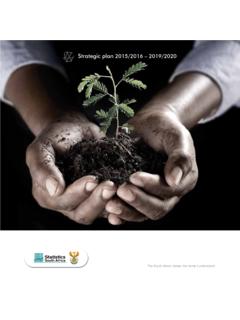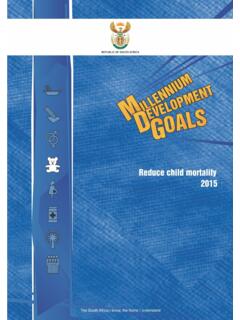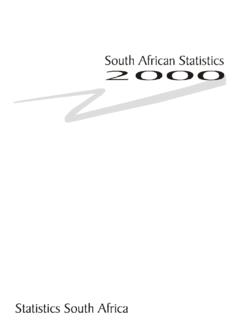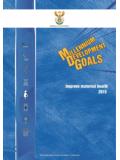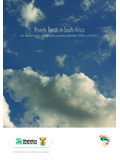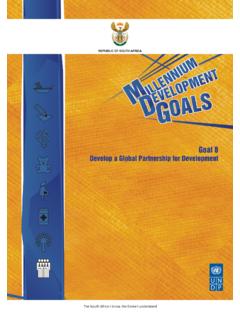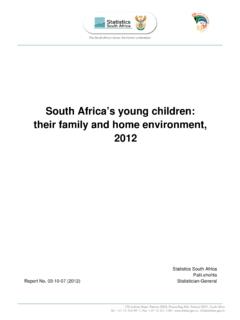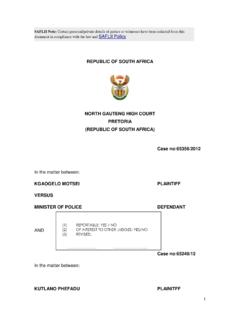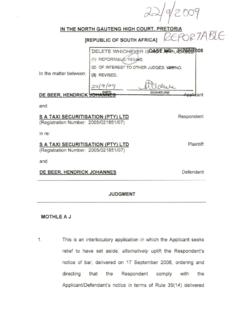Transcription of ISBN 978-0-621-43861-1 - Statistics South Africa
1 I ii The South Africa I know, the home I understand Millennium Development Goals: Country report 2015 / Statistics South Africa Published by Statistics South Africa , Private Bag X44, Pretoria 0001 Stats SA Library Cataloguing-in-Publication (CIP) Data Millennium Development Goals: Country report 2015 / Statistics South Africa . Pretoria: Statistics South Africa , 2015 156 pp isbn 978-0-621-43861-1 iii The South Africa I know, the home I understand FOREWORD Minister TJ Radebe, the Minister in the Presidency: Planning, Monitoring and Evaluation This is the sixth and final Millennium Development Goals report (MDGR), since the adoption of the MDGs in 2000, and it reflects on the achievements made by the people of this country in dealing with the scourge of extreme poverty in all its forms. It also highlights the challenges that still remain.
2 The MDGs were a natural fit for South Africa as they aligned seamlessly with our own development agenda as expressed through the Freedom Charter and were endorsed by successive Governments since 1994, while the basic rights espoused by the MDGs were already entrenched in our Constitution. Thus, implementation of the goals was a confirmation of the developmental path South Africa embarked on and gave further impetus to the endeavours of post-apartheid South Africa . Although the MDGs processes are coming to an end, there are still challenges in achieving the goals that remain, we continue to be committed to the journey that we embarked on a few decades ago. As we move to the next fifteen years of the global development agenda through the Sustainable Development Goals, we take note of the fact that our National Development Agenda, Vision 2030, as espoused in our National Development Plan, reflects our commitment to improving the lives of the poor and marginalised in society: By 2030, we seek to eliminate poverty and reduce inequality.
3 We seek a country wherein all citizens have the capabilities to grasp the ever-broadening opportunities available. Our plan is to change the life chances of millions of our people, especially the youth; life chances that remain stunted by our apartheid history. (National Development Plan, p5). But as this report so vividly illustrates, there are still many challenges that we face as we accelerate our efforts to achieve the MDG goals. We are confident that we have dealt effectively with the goal to halve extreme poverty but we remain deeply concerned that relative inequality remains high, as measured by the Gini Coefficient. This is partly because of the high unemployment rate and the low labour force participation rate in our country. The report also shows that we have exceeded the targets related to universal access to education, but we are keenly aware that we should also include indicators on the efficiency, quality and outputs of the education system.
4 The paucity of good information from the perspective of utility, accessibility and relevance seriously underscores the importance of producing such for South Africa . This is certainly true when progress made in improving maternal mortality is considered, as there is an absence of iv The South Africa I know, the home I understand consensus on the actual level of maternal mortality in South Africa , owing to different data sources and methodology. But we do know and there is an agreement that the counting is lagging behind in measuring progress on the target of reducing the maternal mortality ratio. But as South Africans, we hold each other accountable as we re-affirm our commitment to the MDG goals and the achievement thereof. v The South Africa I know, the home I understand MESSAGE His Excellency Jacob Gedleyihlekisa Zuma, President of the republic of South Africa This ultimate Millennium Development Goals (MDG) report is an incomparable source narrating the story of how South Africa joined the rest of the world in the year 2000 on this critical journey to restore and advance the dignity of humankind and the environment.
5 As part of this international movement we were determined to play our part to rid the world of extreme poverty and the many forms of deprivations that have been haunting all societies for millennia. Notwithstanding the ever-present public pessimism, over the past decade and a half, South Africa has seen discernible improvements in the life circumstances of its citizens. Statistical evidence indicates that South Africa has made inspiring progress in reducing extreme income poverty, largely as a result of a progressive, pro-poor tax system which supports the provision of social assistance such as healthcare, education and other free basic services. I am, however, acutely aware that the levels of poverty among vulnerable groups such as women and children still remain a desperate challenge. South Africa , like many other emerging economies, experienced a serious disruption by the global food and fuel prices as well as the financial crisis to its ability to deliver on MDG1.
6 It is, however, good to keep in mind that the 2010 MDG report has concluded that the country had attained the goal of universal primary education before the targeted date of 2015. It is equally important to make the point that South Africa has become known internationally for its relatively good performance in terms of common measures of gender equality. However, gender-based violence remains a stubborn concern and dealing decisively with this matter is essential for achieving equality and the empowerment of women. It is furthermore worthy to note that South Africa has recorded progress in the expansion of its healthcare infrastructure and improved access to healthcare services for all South Africans. We are mindful that many challenges still abound with respect to matters of healthcare and mortality, but we have made significant progress with regard to the reduction of child mortality, MDG4, and the improvement of maternal health, MDG5.
7 We are acutely aware that the world needs to do much more to fully achieve the eight goals, especially in developing countries. It is our resolve to continue to confront the underlying root causes that create stumbling blocks for universal progress and development head on. vi The South Africa I know, the home I understand Notwithstanding all of these achievements, the republic of South Africa has experienced uneven development since September 2000 and there are some areas that show that more hard work and dedication remain necessary. We are resolved to mobilise all South Africans behind Vision 2030 as outlined in the National Development Plan to address and redress the continued imbalances and the stubborn persistence of unemployment, inequality and poverty. Finally, I express my sincere gratitude to the National Coordinating Committee and the various working groups of the South African government and civil society organisations for their contribution in preparing this report.
8 Vii The South Africa I know, the home I understand ACKNOWLEDGEMENTS This is the sixth and final MDG report I have the pleasure of submitting to the Executive arm of the republic and to the peoples of South Africa . It provides a historical account of South Africa s development in numbers and details the progress we have made as a country towards eradicating extreme poverty in all its forms. This report reflects the 15-year results of intense national efforts from a range of institutions, organisations and individuals to improve the lives of all South Africans, but in particular the poor and the marginalised in society. A great many people have contributed to this report through their participation in various consultative fora across the country, often at great expense and sacrifice. As the MDG process draws to a close I would like to remind all that the work that we started 15 years ago certainly does not end here, and that reporting on this matter will continue through the Sustainable Development Goals (SDGs).
9 From our initial engagements with the SDG process, it has become clear that the demand for good quality information on which to premise our work will increase immensely. In this regard data producers within the South African National Statistics System (SANSS), under the leadership of the Statistician-General and Stats SA, will have to ensure that we can respond to these challenges adequately. I would like to express my gratitude to the following groups and individuals, through whose dedication and sacrifice this report was made possible: the Members of the National Coordinating Committee, (NCC), the various authors, the Extended Report Drafting Team (ERDT), civil society organisations and government departments who contributed greatly to compiling this report. Finally, I would like to thank the public and private institutions who provided the information that forms the bedrock of the reports what underpins this report.
10 Through this national effort we can deliver on the South Africa we know, the Home we Understand . Pali Lehohla, Statistician-General of South Africa and the Chairperson of the National Coordinating Committee for the Millennium Development Goals. viii The South Africa I know, the home I understand South Africa AT A GLANCE Indicator Value 2001 2011 Population Total 44 819 778 51 770 560 Male 21 434 040 25 188 791 Female 23 385 737 26 581 769 Households million million Household size (persons) Average Average Land surface area 1 219 602 km2 Provinces Gauteng, KwaZulu-Natal, North West, Limpopo, Free State, Mpumalanga, Eastern Cape, Western Cape, Northern Cape Key economic sectors Mining, Services, Transport, Energy, Manufacturing and Agriculture Official languages English, isiZulu, isiXhosa, isiNdebele, Afrikaans, siSwati, Sepedi, Sesotho, Setswana, Tshivenda, Xitsonga Government Constitutional multiparty, three spheres (local, provincial, national) democracy Capitals Pretoria (administrative), Cape Town (legislative) Constitutional Court is located in Johannesburg Currency Rand (ZAR)
